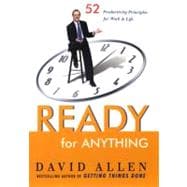
Note: Supplemental materials are not guaranteed with Rental or Used book purchases.
Purchase Benefits
| Acknowledgments | ix | ||||
| Introduction: Making It Easy to Take It Easy | xvii | ||||
| PART I: CLEAR YOUR HEAD FOR CREATIVITY | |||||
|
1 | (40) | |||
|
3 | (3) | |||
|
|||||
|
6 | (3) | |||
|
|||||
|
9 | (3) | |||
|
|||||
|
12 | (3) | |||
|
|||||
|
15 | (3) | |||
|
|||||
|
18 | (3) | |||
|
|||||
|
21 | (3) | |||
|
|||||
|
24 | (2) | |||
|
|||||
|
26 | (3) | |||
|
|||||
|
29 | (3) | |||
|
|||||
|
32 | (3) | |||
|
|||||
|
35 | (3) | |||
|
|||||
|
38 | (3) | |||
|
|||||
| PART II: FOCUS PRODUCTIVELY | |||||
|
41 | (40) | |||
|
43 | (3) | |||
|
|||||
|
46 | (3) | |||
|
|||||
|
49 | (2) | |||
|
|||||
|
51 | (3) | |||
|
|||||
|
54 | (3) | |||
|
|||||
|
57 | (3) | |||
|
|||||
|
60 | (3) | |||
|
|||||
|
63 | (3) | |||
|
|||||
|
66 | (3) | |||
|
|||||
|
69 | (3) | |||
|
|||||
|
72 | (3) | |||
|
|||||
|
75 | (3) | |||
|
|||||
|
78 | (3) | |||
|
|||||
| PART III: CREATE STRUCTURES THAT WORK | |||||
|
81 | (36) | |||
|
83 | (2) | |||
|
|||||
|
85 | (2) | |||
|
|||||
|
87 | (3) | |||
|
|||||
|
90 | (2) | |||
|
|||||
|
92 | (3) | |||
|
|||||
|
95 | (3) | |||
|
|||||
|
98 | (2) | |||
|
|||||
|
100 | (3) | |||
|
|||||
|
103 | (3) | |||
|
|||||
|
106 | (3) | |||
|
|||||
|
109 | (2) | |||
|
|||||
|
111 | (3) | |||
|
|||||
|
114 | (3) | |||
|
|||||
| PART IV: RELAX AND GET IN MOTION | |||||
|
117 | (38) | |||
|
119 | (3) | |||
|
|||||
|
122 | (3) | |||
|
|||||
|
125 | (2) | |||
|
|||||
|
127 | (3) | |||
|
|||||
|
130 | (3) | |||
|
|||||
|
133 | (3) | |||
|
|||||
|
136 | (3) | |||
|
|||||
|
139 | (2) | |||
|
|||||
|
141 | (3) | |||
|
|||||
|
144 | (2) | |||
|
|||||
|
146 | (3) | |||
|
|||||
|
149 | (2) | |||
|
|||||
|
151 | (4) | |||
|
|||||
| PART V: REMIND YOURSELF OF THE FUNDAMENTALS | |||||
|
155 | (10) | |||
|
157 | (3) | |||
|
160 | (1) | |||
|
161 | (2) | |||
|
163 | (2) | |||
| Afterword | 165 |
The New copy of this book will include any supplemental materials advertised. Please check the title of the book to determine if it should include any access cards, study guides, lab manuals, CDs, etc.
The Used, Rental and eBook copies of this book are not guaranteed to include any supplemental materials. Typically, only the book itself is included. This is true even if the title states it includes any access cards, study guides, lab manuals, CDs, etc.